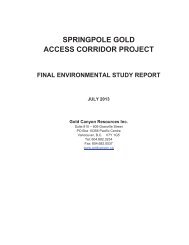Malawi NI 43-101 - December 2011 - Gold Canyon Resources Inc.
Malawi NI 43-101 - December 2011 - Gold Canyon Resources Inc.
Malawi NI 43-101 - December 2011 - Gold Canyon Resources Inc.
- No tags were found...
You also want an ePaper? Increase the reach of your titles
YUMPU automatically turns print PDFs into web optimized ePapers that Google loves.
23(c) Significant historical mineral resources or reservesUsing the Lonrho data Met-Chem (Anonymous (1994)) reported a resource of 25.6MT of bauxite, using a cutoff grade of 30% Al 2 O 3, with an average grade of <strong>43</strong>.3% Al 2 O 3 .However, it must be clearly stated that this historical resource is not <strong>43</strong>-<strong>101</strong>compliant, it is not relied upon in this report, and it is not of exploration interest to<strong>Gold</strong> <strong>Canyon</strong>. More specifically, the bauxite resources, whatever their size or economicpotential, are not germane to the potential REE resources of the Chambe Basin that are thepresent interest of <strong>Gold</strong> <strong>Canyon</strong> on the Mulanje Massif.(d) ProductionThe author knows of no mineral production from the Property.7 GEOLOGICAL SETTING AND MINERALIZATION(a) Regional, local and Property geologyThis part of southern <strong>Malawi</strong> (Figure 8) is underlain by a basement complex (Garsonand Walshaw, 1969) consisting of folded and metamorphosed rocks of Precambrian toLower Paleozoic age, mostly paragneiss, but also including granulites, calcareous gneiss,marble, several types of amphibolite and varieties of mostly migmatitic and anatecticgranite.Intruding the basement complex are rocks of the Chilwa Alkaline Province of UpperJurassic to Lower Cretaceous age. The major alkaline rocks are a series of overlappingsub-circular intrusions of mainly syenite, some quartz syenite and granite that form theMulanje Massif, an inselberg (Figure 5) that rises high above the surrounding plains.The Chambe ring structure (Figure 5, 9) is one of several syenite complexes of theMulanje Massif and is about 8.5 Km across. The outer ring dike syenite(s) form aprominent bare rock rim (Figure 6, 7) that encloses a basin about 3.5 km across withinwhich a central syenite plug has recessively weathered to soils that are up to about 15 mthick and contain scattered syenite boulders (Figure 6, 7) , probably residual joint-boundedblocks (“core stones”). Leachable rare earths in these soils are the main target of the






